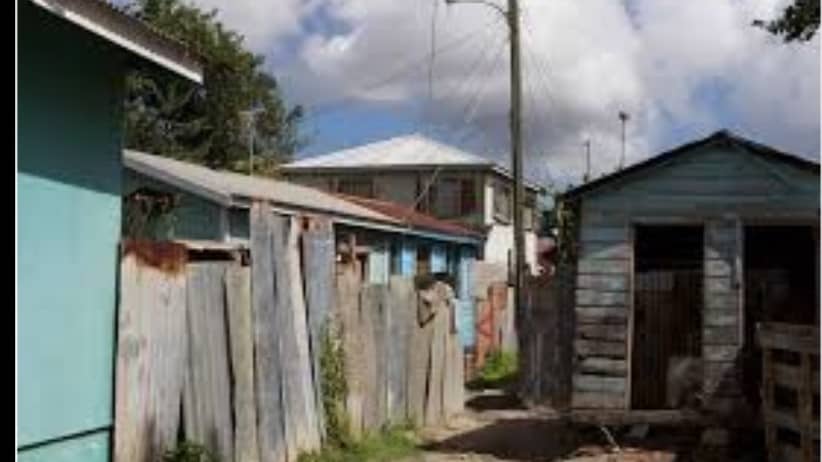

BOOBY ALLEY AND ITS ENVIRONS:
H.D. ANDERSON O’MARDE
Field Research Officer, Department of Culture: August, 202
There was a time when yellow fever was running rampant throughout the island of Antigua, almost annihilating the entire military settlement at Fort Shirley Heights, near the Nelson’s Dockyard. Hundreds of soldiers died at the military settlement and things became so ominous and dreadful that the sailors and soldiers had to be buried in the sand on the beaches and the soft areas surrounding them. It became obvious that a cemetery was necessary.

The space that was eventually chosen to become the graveyard was a location in the lower Point Area, in the city of St. Johns. The demarcation was Wilkinson Cross Street on the eastern side; Mariner’s Lane on the western side; Dickenson Bay Street on the northern side; and North Street on the southern side.
That area holds special historical values for the people of this nation and should be revered for what it means to our society.
It was in that cemetery that King Court and his conspirators used to meet and plot to overthrow the white plantocracy, which had them enslaved. It was there that they drank the ‘Damnation Oath’ of “Death to the white Man”. For their efforts, those revolutionary forefathers were all executed. However, it seems as though their spirits still exist in that area and their determination is as vibrant today as it was then.
It was eventually determined that that low-lying, swampy area was not the ideal choice for a cemetery as there were incidents of coffins floating in flood waters when there was heavy rainfall. Subsequently, the cemetery was relocated to number ten cane field plot at the Gambles Estate. The original cemetery gave birth to dwelling houses that accommodated the poorer and more down-trodden within our society. Black descendants of slaves were allowed to settle in the unwanted, swampy and unhealthy area. It was prevalent with mosquito-borne diseases. Today, it remains densely populated, with inter-connecting alleys, in a maze-like fashion, running through its length and breadth. The area became known as ‘Booby Alley’.
Despite the poverty stricken families that resided in that area, and the deprivation that they suffered, there emerged a people who have made considerable contributions to our nation, especially in the spheres of politics and culture. They have always exhibited their African heritage; portrayed their African culture, and have been instrumental in shaping our history and determining the direction of our nation.
The 1918 riot was conceived and took form from this area. The attack was divided into two separate sections; one moving up St. George’s Street while the other went up North Street and proceeded upward along Newgate Street. The intention was to challenge the colonial authorities at ‘Ram’s Kiddy Corner’. That riot was short lived as many of the rioters were shot down and arrested. This rejected area had produced the spark and ignition for black revolution and had provided fearless energy for the people of this nation.
Out of this area, came the backbone of The Antigua Trades and Labour Union. It was from this union that the Antigua Worker’s Union was born. Both of these unions have contributed considerably to the working class of this nation. It is from these two trade unions that separate political parties were formed, and subsequently, have been instrumental in shaping all of our governments.
The invaluable contributions made to our culture and our cultural products, occasioned by residents of this area, can never be denied. This was the area where the ‘Monkey Band’ started. This was where the suppressed cultural traits of our African forefathers persevered and burgeoned into some of our nation’s pillars of our culture. It was in Booby Alley that the African drums and the dancing of the ‘Mo-ko Jumby’ raised their heads and defied the suppression that was being forced on our forefathers. This was the area that produced the ‘House Coat Bands’ which entertained the masses during the Christmas seasons.
That area has always been replete with people blessed with creative and innovative talents. Located on Mariner’s Lane was Townsend’s blacksmith shop. In Mr. Townsend’s yard there was an abundance of scrap iron, along with bits and pieces of metal. The men from the area resorted to making use of those pieces of scrap iron and, combined with their strong African heritage where rhythm is a part of us, they formed our first iron band. This was called Hell’s Gate Iron Band, as the “raucous din” was viewed as akin to the sound that could only be expected to emanate from the gates of hell. Of course, as was to be expected, the iron band was not permitted to play in certain areas. A ‘No Play Zone’ was created so that the ghetto youths from Booby Alley had to keep away from the isolated upper middle-class blacks and the whites on the island. From the corner of Newgate and Thames Streets, up to Market Street, down to the bridge at the corner of South Street, was the region designated as the ‘No Play Zone’. Eventually, the iron band persevered and evolved into the ‘Hell’s Gate Steel Orchestra’.
Having heard reports of the steel band in Trinidad, the youngsters from that area began a quest towards creating their own. After experimenting with pan building for some time, Hell’s Gate Steel Orchestra emerged, becoming the first steel band in the country. Hell’s Gate Steel Orchestra has made us all proud as the band has gone on to accomplish feats far above anyone’s expectation. Hell’s Gate Steel Orchestra has defied all odds and has established itself as a true and valuable component of our cultural identity. The band has been recognized as the product of consummate innovators by being the first in many aspects relating to steel band, both here and the international community. The abundance of talented and skilled pan players within the Hell’s Gate Steel Orchestra was sufficient to withstand fragmentations, which saw some of its members moving away and forming two separate steel bands; the ‘Harmonite’s Steel Orchestra’ and the ‘Super Stars Steel Orchestra’. Hell’s Gate Steel Orchestra’s tenacity is so fierce that they still exist and are the current national steel band champions.
From the bowels of that swampy area, there has ensued, a people who have proven that they deserve better recognition for the significant contributions made by them and their fore-parents. Boasting a history brimming with positive achievements, the residents of Booby Alley must be complimented. They must also be assisted with raising their standard of living, starting with better housing. Fortunately, a person blessed with compassion, has stepped up to the plate. Our Prime Minister, the Parliamentary Representative for that neighbourhood, has committed to improving the squalid and cramped conditions under which they still exist. In addition, we can only hope that the astronomical contributions which have been made by the earlier residents of that area will not be swept into the dust-bin of history. As part of the beautification process, a plaque commemorating some of the residents who have made positive influences to the inscrutability and mystique of Booby Alley, should find a place in a position of prominent and permanent display. There must be a determined pledge to preserve the history, the efforts and the contributions made to this nation by the people of Booby Alley and its environs.
Appendix:
Article primarily based on oral transmissions as Folklore, passed down in the traditional African Griot medium
Main oral historians who contributed are:
Sir Selwyn Walter
Barry Stevens
Sir Keithlyn Smith
Advertise with the mоѕt vіѕіtеd nеwѕ ѕіtе іn Antigua!
We offer fully customizable and flexible digital marketing packages.
Contact us at [email protected]















Some of these areas should have been historical site for our tourism products. Most tourists travel for history.
Comments are closed.